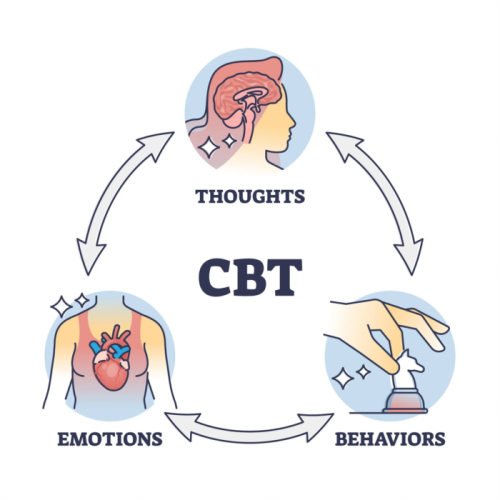The Core Principle of Cognitive Behavioral Therapy: Understanding its Foundation
The core principles of CBT/What is CBT
In Cognitive Behavioral Therapy or CBT, childhood experiences and events are not the focus, and neither is delving into the unconscious. Rather the focus of CBT is on the here-and-now. CBT aims to address the present and emphasizes a skills based, interactive, problem-focused, collaborative approach. CBT is evidence-based and only uses techniques and interventions that are grounded in research. Cognitive Behavioral Therapy has become one of the most widely used therapeutic approaches.
Cognitive Behavioral Therapy (CBT) is a goal-oriented method of therapy that is based on the principle that thoughts (what we think), feelings (emotions) and behaviors (actions) are interconnected. Our thoughts influence our feelings and our feelings influence our behaviors.

CBT helps to identify distorted thought patterns or cognitions and understand how they negatively impact feelings and behaviors. CBT teaches patients to change negative thoughts and beliefs, to improve mood and reduce problematic behavior patterns. Basically if we want to change the way we feel, we will need to change our thoughts and our actions.
CBT is effective in treating a wide range of mental illnesses such as
- Anxiety
- Phobia
- Panic
- Anger
- Depression
- Insomnia
- Obsessive Compulsive Disorder (OCD)
- Attention Deficit Hyperactivity Disorder (ADHD)
- Bipolar Disorder, and
- Post Traumatic Stress Disorder (PTSD)
This form of therapy is effective regardless of gender, age, race, ethnicity, and sexual orientation.
Harnessing the Power of Thought
Harnessing the power of thought
The power of our thoughts is enormous. In fact, the power of thinking is what CBT is centered on. Thoughts are a powerful tool and, contrary to what some may believe, we are very much able to influence our thoughts.
We may underestimate the power of the mind and may fail to recognize that our thoughts are what we choose to allow. A major concept in Cognitive Behavioral Therapy is an “automatic thought”. These are thoughts that pop into our minds. As humans, we have many thoughts that come into our mind’s on a daily basis. Although we cannot control the thoughts from coming into our minds, we choose how to respond to the thoughts such as which ones we will entertain and which ones we won’t. Sometimes we may become stuck in ruminative thinking or negative thought patterns that loop repeatedly in our minds if we hone in on negative thoughts.
We can elect to focus on positive thoughts or negative ones: it’s what we choose to give attention to. For example, we can choose to see the glass half empty or half full, yet this doesn’t change the amount in the glass. It’s the perception or mentality that we have which can dictate reality either negatively or positively. This determines how we feel and behave.
Taking a glass half empty approach in life will lead to negative feelings and behaviors. By contrast, taking a glass half full approach will lead to more positive feelings and behaviors.
How Cognitive Behavioral Therapy Leads to Effective Change
How CBT leads to effective change
CBT emphasizes the role of cognitions (automatic thoughts). The first step in CBT is being aware of automatic thoughts that may arise. Gaining this insight is vital but not sufficient. Your therapist will help teach you what to do with this insight to better your life.
During the process of therapy, your therapist will help you identify distorted thinking (or cognitive distortions) that may contribute to negative feelings and unhelpful/unhealthy behaviors. Such cognitive distortions could be catastrophizing which involves jumping to worst-case scenarios and believing that the outcome will not be manageable or all-or-nothing thinking which is black- and -white thinking and involves viewing things in absolute terms (e.g., “ good” or “bad”).
Monitoring and recording automatic thoughts brings awareness to negative thought patterns. Your therapist will then help address the thoughts/thought patterns. You will learn strategies to challenge irrational thoughts and replace them with rational ones. This will change behavioral patterns, in turn, and decrease distress.
CBT will also provide you coping skills. Throughout therapy, with support, you will cultivate the skills to help modify thought patterns as well as behaviors which will lead to positive feelings. Eventually, you will be able to manage thoughts and emotions effectively all on your own.
A Path to Long-Term Transformation
Path to long term transformation
CBT emphasizes collaboration and active participation where you work together with your therapist. This mode of therapy teaches you skills to become your own therapist over time. For CBT to be effective long term, active participation is required and a willingness to discuss thoughts is necessary.
Additionally, a commitment to doing the work (homework) that may be given to you by your therapist is imperative in making sure you reap long term benefits. According to research, the more you practice the skills learned in therapy, the better the treatment outcome.
Shaping Thoughts for Well-being
Shaping thoughts for well being
While we often separate the two, mental well being and physical well being go hand in hand. The brain is the leader of our body and when we attend to the mind as well as the body, we help keep our entire system going. Our thoughts are a huge factor in maintaining mental well being.
Our thoughts and behaviors can directly affect our emotional well-being and physical health. Irrational automatic thoughts can cause functional impairment in our behavior and can have a negative impact on day-to-day life. CBT is used to promote mental well being when thoughts interfere with our way of life and functioning to our fullest potential. This therapy helps to shape thought patterns for better mental wellbeing.

